davecarter
New Member
If any could help. just about to give up!
I have posted before but I did not get a resolution to this issue.
I am trying to get two rc engines to sync.
The first step is read the speed of both enignes.
I have decided to use a hall sensor fo this. I have a rig setup where the pulses from the hall sensor are read by an 18m2. I sarted by using a "count " command. But I felt that the accuracy was not going to be very good. So I have tried "pulsin". What I found is that, when the pulse is slow. ie 1000rpm (16 pulses per second) Other commands are affected. In fact when the pulse is high the servo still does not act as it should.
What I need to do is to use the pulsin variable to position a servo. The servo command in this case is unusable. The servo just goes nuts.
So what I thought is that I could generate a signal either a serial or varying voltage to send it to another picaxe which intern would read the signal and control the servo.
I have no experiance in generating a varying voltage or serial output which can be read by another picaxe.
Please help.
Dave.
I have posted before but I did not get a resolution to this issue.
I am trying to get two rc engines to sync.
The first step is read the speed of both enignes.
I have decided to use a hall sensor fo this. I have a rig setup where the pulses from the hall sensor are read by an 18m2. I sarted by using a "count " command. But I felt that the accuracy was not going to be very good. So I have tried "pulsin". What I found is that, when the pulse is slow. ie 1000rpm (16 pulses per second) Other commands are affected. In fact when the pulse is high the servo still does not act as it should.
What I need to do is to use the pulsin variable to position a servo. The servo command in this case is unusable. The servo just goes nuts.
So what I thought is that I could generate a signal either a serial or varying voltage to send it to another picaxe which intern would read the signal and control the servo.
I have no experiance in generating a varying voltage or serial output which can be read by another picaxe.
Please help.
Dave.

